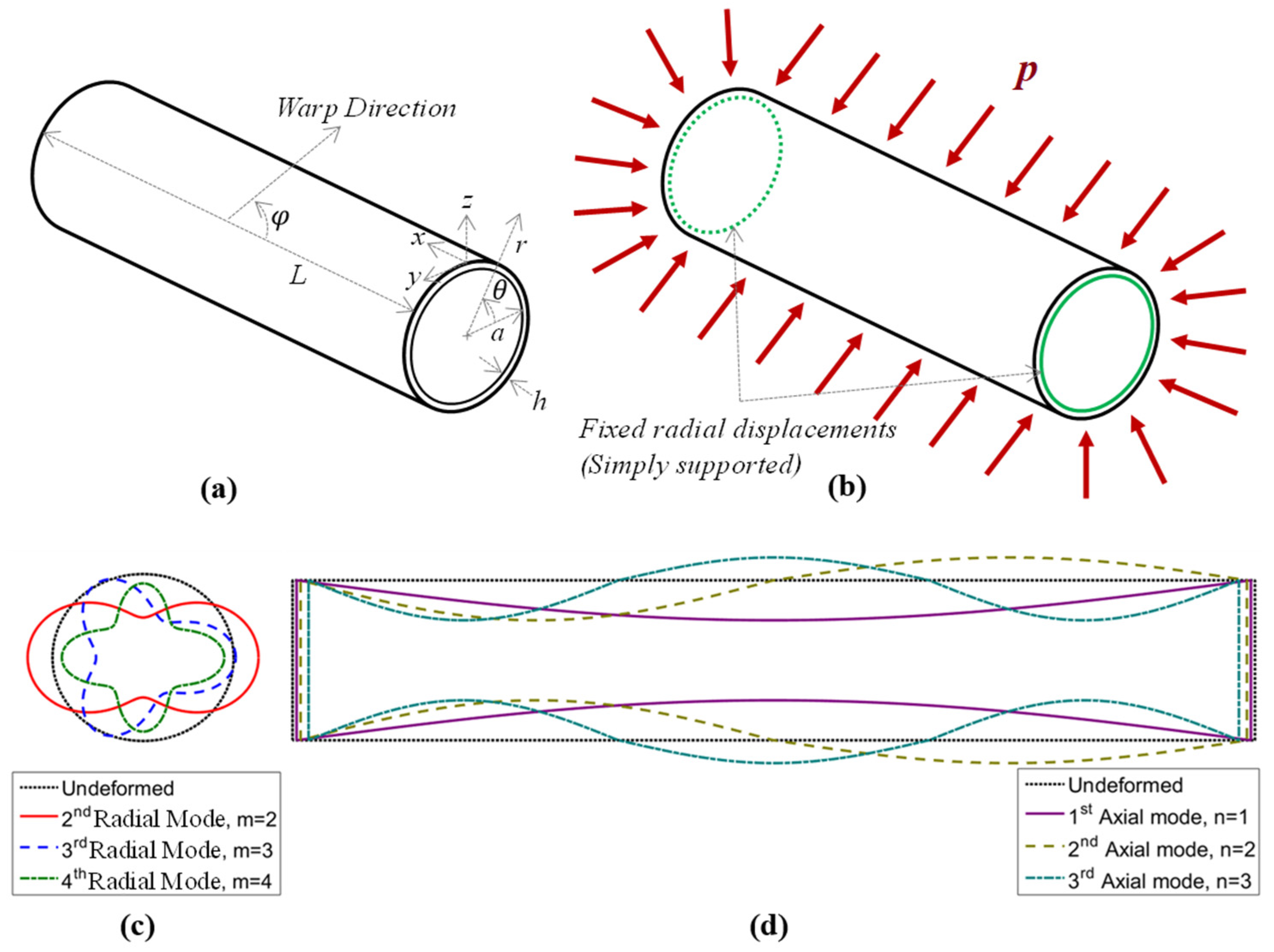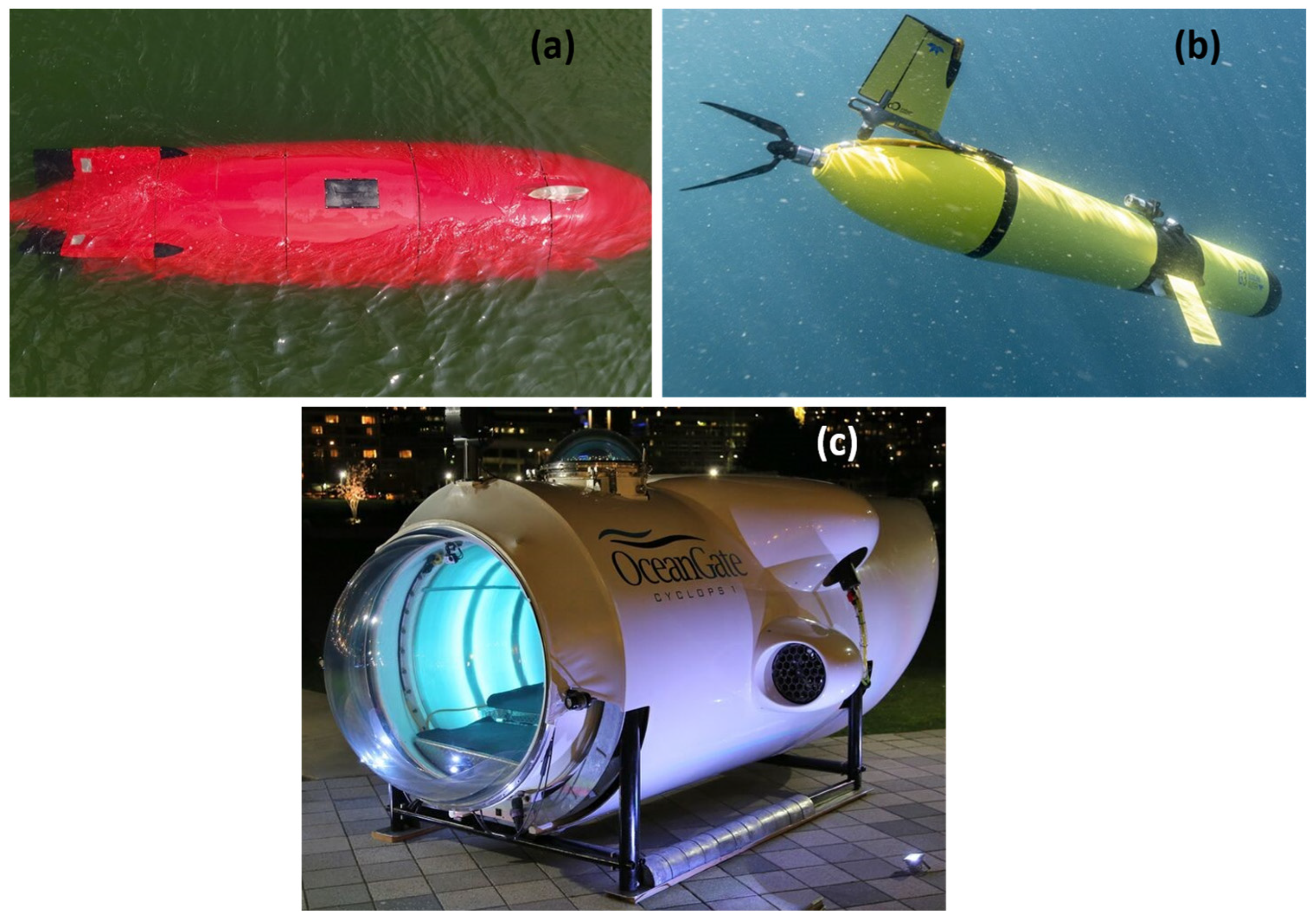Review of Implosion Design Considerations for Underwater Composite Pressure Vessels
Abstract
:1. Introduction
2. Background
2.1. Evolution of Composite Pressure Hulls
2.2. Choosing Composites
3. Composite Pressure Hull Failure
3.1. Buckling Failure
Composite Buckling Solution

3.2. Material Failure
3.3. Material Degradation
3.4. Pressure Gradients
3.5. Temperature Fluctuations
3.6. Fatigue
4. Design of Composite Pressure Hulls
4.1. Material Selection
4.2. Accounting Failure
4.3. Composite Layup Optimization
4.4. Additional Considerations
4.4.1. Manufacturing Methods
4.4.2. Performance Monitoring
4.4.3. Testing and Safety Standards Post Initial Design
5. Case Studies
5.1. Titan Submersible
5.2. Other Implosion Failures
6. Concluding Remarks
Funding
Institutional Review Board Statement
Informed Consent Statement
Data Availability Statement
Conflicts of Interest
References
- Mouritz, A.P.; Gellert, E.; Burchill, P.; Challis, K. Review of advanced composite structures for naval ships and submarines. Compos. Struct. 2001, 53, 21–42. [Google Scholar] [CrossRef]
- Ngwa, A.N.; Chaudhary, B.; Matos, H.; Shukla, A. Underwater Implosion and Energy Mitigation of Hybrid Glass-Carbon Composite Shells. J. Mar. Sci. Eng. 2023, 11, 2147. [Google Scholar] [CrossRef]
- Pinto, M.; Gupta, S.; Shukla, A. Study of implosion of carbon/epoxy composite hollow cylinders using 3-D Digital Image Correlation. Compos. Struct. 2015, 119, 272–286. [Google Scholar] [CrossRef]
- Moon, C.-J.; Kim, I.-H.; Choi, B.-H.; Kweon, J.-H.; Choi, J.-H. Buckling of filament-wound composite cylinders subjected to hydrostatic pressure for underwater vehicle applications. Compos. Struct. 2010, 92, 2241–2251. [Google Scholar] [CrossRef]
- What Was the ‘Catastrophic Implosion’ of the Titan Submersible? An Expert Explains. RNZ 2023. Available online: https://www.rnz.co.nz/news/world/492554/what-was-the-catastrophic-implosion-of-the-titan-submersible-an-expert-explains (accessed on 21 July 2024).
- University, N. Carbon-Fiber Conundrum: Physicist Explains the Tragic Implosion of OceanGate’s Titan Submersible. SciTechDaily 2023. Available online: https://scitechdaily.com/carbon-fiber-conundrum-physicist-explains-the-tragic-implosion-of-oceangates-titan-submersible/ (accessed on 21 July 2024).
- ‘Catastrophic Implosion’ and Five Dead: What We Know about Doomed Titanic sub. The Independent 2023. Available online: https://www.independent.co.uk/news/world/americas/titanic-sub-implosion-what-happened-b2367802.html (accessed on 21 July 2024).
- Ikeda, C.M.; Wilkerling, J.; Duncan, J.H. The implosion of cylindrical shell structures in a high-pressure water environment. Proceedings of the Royal Society A: Mathematical. Phys. Eng. Sci. 2013, 469, 20130443. [Google Scholar] [CrossRef]
- Ngwa, A.; Rossell, V.; Matos, H.; Shukla, A. Effects of ring stiffeners on the underwater collapse behavior of carbon/epoxy composite tubes. J. Compos. Mater. 2023, 57, 1755–1767. [Google Scholar] [CrossRef]
- Matos, H.; Kishore, S.; Salazar, C.; Shukla, A. Buckling, vibration, and energy solutions for underwater composite cylinders. Compos. Struct. 2020, 244, 112282. [Google Scholar] [CrossRef]
- Gupta, S.; Matos, H.; Shukla, A.; LeBlanc, J.M. Pressure signature and evaluation of hammer pulses during underwater implosion in confining environments. J. Acoust. Soc. Am. 2016, 140, 1012–1022. [Google Scholar] [CrossRef]
- Farhat, C.; Wang, K.G.; Main, A.; Kyriakides, S.; Lee, L.H.; Ravi-Chandar, K.; Belytschko, T. Dynamic implosion of underwater cylindrical shells: Experiments and Computations. Int. J. Solids Struct. 2013, 50, 2943–2961. [Google Scholar] [CrossRef]
- Messager, T.; Pyrz, M.; Gineste, B.; Chauchot, P. Optimal laminations of thin underwater composite cylindrical vessels. Compos. Struct. 2002, 58, 529–537. [Google Scholar] [CrossRef]
- Koudela, K.L.; Strait, L.H. Simplified Methodology for Prediction of Critical Buckling Pressure for Smooth-Bore Composite Cylindrical Shells. J. Reinf. Plast. Compos. 1993, 12, 570–583. [Google Scholar] [CrossRef]
- Yang, C.; Pang, S.-S.; Zhao, Y. Buckling Analysis of Thick-Walled Composite Pipe under External Pressure. J. Compos. Mater. 1997, 31, 409–426. [Google Scholar] [CrossRef]
- Matos, H.; Chaudhary, B.; Ngwa, A.N. Optimization of Composite Cylindrical Shell Structures for Hydrostatic Pressure Loading. J. Press. Vessel. Technol. 2022, 145, 011504. [Google Scholar] [CrossRef]
- Davies, P. Environmental degradation of composites for marine structures: New materials and new applications. Philos. Trans. R. Soc. A Math. Phys. Eng. Sci. 2016, 374, 20150272. [Google Scholar] [CrossRef] [PubMed]
- Li, Y.; Yu, C.; Wang, W.; Li, H.; Jiang, X. A Review on Structural Failure of Composite Pressure Hulls in Deep Sea. J. Mar. Sci. Eng. 2022, 10, 1456. [Google Scholar] [CrossRef]
- Wanchoo, P.; Matos, H.; Rousseau, C.-E.; Shukla, A. Investigations on air and underwater blast mitigation in polymeric composite structures—A review. Compos. Struct. 2021, 263, 113530. [Google Scholar] [CrossRef]
- Wanchoo, P.; Chaudhary, B.; Li, H.-W.-X.; Matos, H.; Shukla, A. Blast failure and energy analysis of rubber-modified carbon-fiber vinyl-ester composite laminates. Mech. Mater. 2023, 183, 104685. [Google Scholar] [CrossRef]
- BPVC Section X-Fiber-Reinforced Plastic Pressure Vessels—ASME. Available online: https://www.asme.org/codes-standards/find-codes-standards/bpvc-x-bpvc-section-x-fiber-reinforced-plastic-pressure-vessels/2023/print-book (accessed on 22 July 2024).
- Shillings, C.; Javier, C.; LeBlanc, J.; Tilton, C.; Corvese, L.; Shukla, A. Experimental and computational investigation of the blast response of Carbon-Epoxy weathered composite materials. Compos. Part B Eng. 2017, 129, 107–116. [Google Scholar] [CrossRef]
- Chaudhary, B.; Li, H.; Ngwa, A.N.; Matos, H. Investigating the effects of Coating systems on the degradation behavior of 3D-Printed pressure vessels. Mar. Struct. 2024, 93, 103540. [Google Scholar] [CrossRef]
- Pinto, M.; Matos, H.; Gupta, S.; Shukla, A. Experimental Investigation on Underwater Buckling of Thin-Walled Composite and Metallic Structures. J. Press. Vessel. Technol. 2016, 138, 4032703. [Google Scholar] [CrossRef]
- Javier, C.; Matos, H.; Shukla, A. Hydrostatic and blast initiated implosion of environmentally degraded Carbon-Epoxy composite cylinders. Compos. Struct. 2018, 202, 897–908. [Google Scholar] [CrossRef]
- Matos, H.; Javier, C.; LeBlanc, J.; Shukla, A. Underwater nearfield blast performance of hydrothermally degraded carbon–epoxy composite structures. Multiscale Multidiscip. Model Exp. Des. 2018, 1, 33–47. [Google Scholar] [CrossRef]
- Chaudhary, B.; Li, H.; Matos, H. Long-term mechanical performance of 3D printed thermoplastics in seawater environments. Results Mater. 2023, 2023, 100381. [Google Scholar] [CrossRef]
- Pinto, M.; Shukla, A. Shock-Initiated Buckling of Carbon/Epoxy Composite Tubes at Sub-Critical Pressures. Exp. Mech. 2016, 56, 583–594. [Google Scholar] [CrossRef]
- Matos, H.; Galuska, M.; Javier, C.; Kishore, S.; LeBlanc, J.; Shukla, A. A review of underwater shock and fluid–structure interactions. Flow 2024, 4, E10. [Google Scholar] [CrossRef]
- LeBlanc, J.; Cavallaro, P.; Torres, J.; Ponte, D.; Warner, E.; Saenger, R.; Mforsoh, I.N.; Shukla, A. Low temperature effects on the mechanical, fracture, and dynamic behavior of carbon and E-glass epoxy laminates. Int. J. Lightweight Mater. Manuf. 2020, 3, 344–356. [Google Scholar] [CrossRef]
- Composite Submersibles: Under Pressure in Deep, Deep Waters. 2024. Available online: https://www.compositesworld.com/articles/composite-submersibles-under-pressure-in-deep-deep-waters (accessed on 21 July 2024).
- Tube Manufacturing. Vitech Composites. Available online: https://www.vitechcomposites.com/en/tube-manufacturing/ (accessed on 21 July 2024).
- Amelia, C. The Art and Science Behind Roll-Wrapped Composite Tubes. GoodwindsCom 2024. Available online: https://goodwinds.com/the-art-and-science-behind-roll-wrapped-composite-tubes/ (accessed on 21 July 2024).
- Rock West. 4 Methods For Producing Composite Tubing|Rock West Composites. 2022. Available online: https://www.rockwestcomposites.com/4-methods-for-producing-composite-tubing.html?srsltid=AfmBOoqMjr2ORyjCe5BZE7qaXtzqeSmuMkJBJvICdc9QupoN7Y29jtjg (accessed on 21 July 2024).
- Chaudhary, B.; Winnard, T.; Oladipo, B.; Das, S.; Matos, H. Review of Fiber-Reinforced Composite Structures with Multifunctional Capabilities through Smart Textiles. Textiles 2024. submitted for publication. [Google Scholar]
- Di Sante, R. Fibre Optic Sensors for Structural Health Monitoring of Aircraft Composite Structures: Recent Advances and Applications. Sensors 2015, 15, 18666–18713. [Google Scholar] [CrossRef]
- Hassani, S.; Mousavi, M.; Gandomi, A.H. Structural Health Monitoring in Composite Structures: A Comprehensive Review. Sensors 2022, 22, 153. [Google Scholar] [CrossRef]
- Chaudhary, B.; Matos, H.; Das, S.; Owens, J. Multifunctional composite structures with embedded conductive yarns for shock load monitoring and failure detection. Smart Mater. Struct. 2024, 33, 037001. [Google Scholar] [CrossRef]
- Awad, Z.K.; Aravinthan, T.; Zhuge, Y.; Gonzalez, F. A review of optimization techniques used in the design of fibre composite structures for civil engineering applications. Mater. Des. 2012, 33, 534–544. [Google Scholar] [CrossRef]
- The Titan Tragedy—A Deep Dive into Carbon Fiber, Used for the First Time in a Submersible. EngineeringCom. Available online: https://www.engineering.com/story/the-titan-tragedy-a-deep-dive-into-carbon-fiber-used-for-the-first-time-in-a-submersible (accessed on 20 February 2024).
- Brasch, B.; Rosenzweig-Ziff, D.; Westfall, S. Titan’s Experimental Design Drew Concern Even before Its Doomed Dive. Washington Post, 23 June 2023. [Google Scholar]
- Carbon Fiber and Advanced Composite Materials. Available online: https://www.mitsubishi-chemical.de/accounts/mce/dropbox/cadki.pdf (accessed on 20 August 2024).
- Composites Pin Board: Solutions for Obtaining Unidirectional Composite Material Properties—Simulation Blog. Available online: https://blogs.autodesk.com/simulation/2017/02/15/composites-pin-board-solutions-for-obtaining-unidirectional-composite-material-properties/ (accessed on 20 February 2024).
- Dvorak, G. Micromechanics of Composite Materials; Springer: Dordrecht, The Netherlands, 2013; Volume 186. [Google Scholar] [CrossRef]
- Guenot, M. Photos of the Titan Sub’s Wreckage Support the Theory That the Carbon-Fiber Hull Failed First, Expert Says. Business Insider. Available online: https://www.businessinsider.com/titanic-sub-photos-suggest-carbon-fiber-hull-to-blame-expert-says-2023-6 (accessed on 29 July 2024).
- Kishore, S.; Naik Parrikar, P.; Shukla, A. Response of an underwater cylindrical composite shell to a proximal implosion. J. Mech. Phys. Solids 2021, 152, 104414. [Google Scholar] [CrossRef]
- Helal, M.; Huang, H.; Fathallah, E.; Wang, D.; Mokbel ElShafey, M.; Ali, M.A. Numerical Analysis and Dynamic Response of Optimized Composite Cross Elliptical Pressure Hull Subject to Non-Contact Underwater Blast Loading. Appl. Sci. 2019, 9, 3489. [Google Scholar] [CrossRef]







| Material | Tensile Modulus (GPa) | Tensile Strength (MPa) | Density (g/cm3) | Elongation (%) | Filament Diameter (µm) |
|---|---|---|---|---|---|
| Grafil 37-800 carbon fiber | 255 | 5520 | 1.81 | 2.16 | 6 |
| Epon resin 862 + Lindride LS-81K curing agent | 2.73 | 73.77 | 1.16 | 5 | - |
| Properties | Values |
|---|---|
| E11 (GPa) | 154 |
| E22 (GPa) | 8.85 |
| v12 | 0.32 |
| G12 (GPa) | 3 |
| A (N/m) | |
| B (N) | |
| D (N m) |
Disclaimer/Publisher’s Note: The statements, opinions and data contained in all publications are solely those of the individual author(s) and contributor(s) and not of MDPI and/or the editor(s). MDPI and/or the editor(s) disclaim responsibility for any injury to people or property resulting from any ideas, methods, instructions or products referred to in the content. |
© 2024 by the authors. Licensee MDPI, Basel, Switzerland. This article is an open access article distributed under the terms and conditions of the Creative Commons Attribution (CC BY) license (https://creativecommons.org/licenses/by/4.0/).
Share and Cite
Matos, H.; Ngwa, A.N.; Chaudhary, B.; Shukla, A. Review of Implosion Design Considerations for Underwater Composite Pressure Vessels. J. Mar. Sci. Eng. 2024, 12, 1468. https://doi.org/10.3390/jmse12091468
Matos H, Ngwa AN, Chaudhary B, Shukla A. Review of Implosion Design Considerations for Underwater Composite Pressure Vessels. Journal of Marine Science and Engineering. 2024; 12(9):1468. https://doi.org/10.3390/jmse12091468
Chicago/Turabian StyleMatos, Helio, Akongnwi Nfor Ngwa, Birendra Chaudhary, and Arun Shukla. 2024. "Review of Implosion Design Considerations for Underwater Composite Pressure Vessels" Journal of Marine Science and Engineering 12, no. 9: 1468. https://doi.org/10.3390/jmse12091468
APA StyleMatos, H., Ngwa, A. N., Chaudhary, B., & Shukla, A. (2024). Review of Implosion Design Considerations for Underwater Composite Pressure Vessels. Journal of Marine Science and Engineering, 12(9), 1468. https://doi.org/10.3390/jmse12091468








